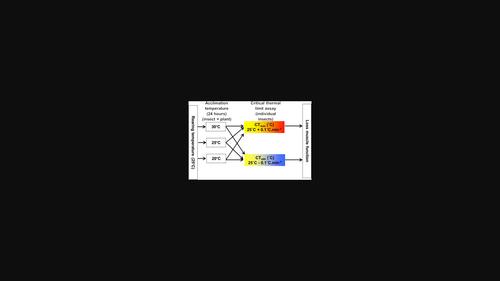当前位置:
X-MOL 学术
›
Physiol. Entomol.
›
论文详情
Our official English website, www.x-mol.net, welcomes your feedback! (Note: you will need to create a separate account there.)
Developmental diet, life stage and thermal acclimation affect thermal tolerance of the fall armyworm, Spodoptera frugiperda
Physiological Entomology ( IF 1.5 ) Pub Date : 2023-07-26 , DOI: 10.1111/phen.12414 Siphephelo M. Phungula 1 , Kerstin Krüger 1 , Robert S. Nofemela 2 , Christopher W. Weldon 1
Physiological Entomology ( IF 1.5 ) Pub Date : 2023-07-26 , DOI: 10.1111/phen.12414 Siphephelo M. Phungula 1 , Kerstin Krüger 1 , Robert S. Nofemela 2 , Christopher W. Weldon 1
Affiliation

|
Insect thermal tolerance affects survival and distribution of species but can vary within and between individuals due to the environmental conditions they experience. The fall armyworm (FAW), Spodoptera frugiperda (J. E. Smith) (Lepidoptera: Noctuidae), recently invaded Africa and its local hotspots are associated with weather and crop phenology. We investigated the effects of larval diet (maize plants, wheat plants or chickpea-based artificial diet), life stages and acclimation temperature on thermal tolerance traits of FAW to explore how these variables might contribute to its presence in the field. First and sixth instar larvae and adults reared on each diet at 25°C were acclimated for 24 h at 20, 25 or 30°C. We then recorded the critical thermal minimum (CTmin) and critical thermal maximum (CTmax) of individuals. Sixth instars had the highest CTmin but the effects of acclimation and diet on this trait depended on the life stage being tested. CTmin of first instars increased with acclimation temperature when fed on an artificial diet, but sixth instars and adults were not affected by acclimation or larval diet. CTmax was lowest among adults but acclimation and diet again had effects that differed between life stages. CTmax of first instars and adults increased with acclimation temperature but not in sixth instars. Sixth instars and adults reared on the artificial diet had the highest CTmax but diet had no effect on first instar CTmax. Our results show the complexity of thermal tolerance across FAW life stages and suggest the need to consider local temperature variation and available dietary resources when predicting their potential distribution.
中文翻译:

发育饮食、生命阶段和热适应影响草地贪夜蛾的热耐受性
昆虫的耐热性影响物种的生存和分布,但由于它们所经历的环境条件,个体内部和个体之间可能存在差异。秋粘虫 (FAW)、草地贪夜蛾(JE Smith)(鳞翅目:夜蛾科)最近入侵非洲,其局部热点与天气和作物物候有关。我们研究了幼虫饮食(玉米植物、小麦植物或以鹰嘴豆为基础的人工饲料)、生命阶段和驯化温度对秋粘虫耐热性状的影响,以探讨这些变量如何影响其在田间的存在。在 25°C 下以每种饮食饲养的一龄和六龄幼虫和成虫在 20、25 或 30°C 下适应 24 小时。然后,我们记录了个体的临界热最小值 (CT min ) 和临界热最大值 (CT max )。第六龄的 CT分钟最高,但适应环境和饮食对这一性状的影响取决于所测试的生命阶段。当人工饲料喂养时,一龄虫的CT min随驯化温度的升高而增加,但六龄虫和成虫不受驯化或幼虫饲料的影响。成年人的CT max最低,但适应环境和饮食对不同生命阶段的影响又有所不同。一龄虫和成虫的CT max随驯化温度的升高而增加,但六龄虫的CT max 不增加。人工饲料喂养的六龄和成虫的CT max最高,但饲料对一龄CT max没有影响。我们的结果显示了秋粘虫生命阶段耐热性的复杂性,并表明在预测其潜在分布时需要考虑当地温度变化和可用的饮食资源。
更新日期:2023-07-26
中文翻译:

发育饮食、生命阶段和热适应影响草地贪夜蛾的热耐受性
昆虫的耐热性影响物种的生存和分布,但由于它们所经历的环境条件,个体内部和个体之间可能存在差异。秋粘虫 (FAW)、草地贪夜蛾(JE Smith)(鳞翅目:夜蛾科)最近入侵非洲,其局部热点与天气和作物物候有关。我们研究了幼虫饮食(玉米植物、小麦植物或以鹰嘴豆为基础的人工饲料)、生命阶段和驯化温度对秋粘虫耐热性状的影响,以探讨这些变量如何影响其在田间的存在。在 25°C 下以每种饮食饲养的一龄和六龄幼虫和成虫在 20、25 或 30°C 下适应 24 小时。然后,我们记录了个体的临界热最小值 (CT min ) 和临界热最大值 (CT max )。第六龄的 CT分钟最高,但适应环境和饮食对这一性状的影响取决于所测试的生命阶段。当人工饲料喂养时,一龄虫的CT min随驯化温度的升高而增加,但六龄虫和成虫不受驯化或幼虫饲料的影响。成年人的CT max最低,但适应环境和饮食对不同生命阶段的影响又有所不同。一龄虫和成虫的CT max随驯化温度的升高而增加,但六龄虫的CT max 不增加。人工饲料喂养的六龄和成虫的CT max最高,但饲料对一龄CT max没有影响。我们的结果显示了秋粘虫生命阶段耐热性的复杂性,并表明在预测其潜在分布时需要考虑当地温度变化和可用的饮食资源。



























 京公网安备 11010802027423号
京公网安备 11010802027423号